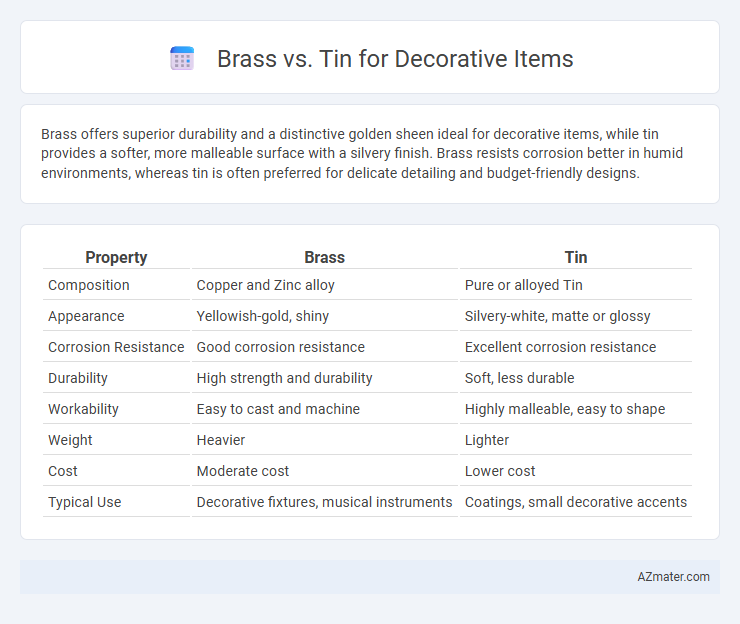Brass offers superior durability and a distinctive golden sheen ideal for decorative items, while tin provides a softer, more malleable surface with a silvery finish. Brass resists corrosion better in humid environments, whereas tin is often preferred for delicate detailing and budget-friendly designs.
Table of Comparison
| Property | Brass | Tin |
|---|---|---|
| Composition | Copper and Zinc alloy | Pure or alloyed Tin |
| Appearance | Yellowish-gold, shiny | Silvery-white, matte or glossy |
| Corrosion Resistance | Good corrosion resistance | Excellent corrosion resistance |
| Durability | High strength and durability | Soft, less durable |
| Workability | Easy to cast and machine | Highly malleable, easy to shape |
| Weight | Heavier | Lighter |
| Cost | Moderate cost | Lower cost |
| Typical Use | Decorative fixtures, musical instruments | Coatings, small decorative accents |
Introduction to Brass and Tin in Decorative Items
Brass, an alloy of copper and zinc, is prized in decorative items for its bright gold-like appearance and excellent workability, making it ideal for intricate designs and durable finishes. Tin, a soft, malleable metal often used as a protective coating or in pewter alloys, offers a muted silver tone that lends a rustic or antique look to decorative pieces. Both metals provide unique aesthetic qualities and corrosion resistance, influencing their choice in different styles of home decor and ornamental applications.
Historical Use of Brass and Tin for Décor
Brass has been historically favored for decorative items due to its durability, warm golden hue, and ability to be intricately worked into detailed designs, commonly seen in antique candlesticks, hardware, and ornamental fixtures dating back to ancient civilizations. Tin, often used as a base metal in tin-plated or pewter items, gained popularity in Europe during the Middle Ages for affordable decorative ware, including plates, mugs, and small sculptures, prized for its silvery appearance and malleability. Both metals reflect cultural aesthetics and technological advancements, with brass symbolizing wealth and permanence, while tin offered a practical alternative for widespread decorative use.
Physical Properties: Brass vs Tin
Brass exhibits superior strength and durability compared to tin, with a higher tensile strength and excellent corrosion resistance, making it ideal for long-lasting decorative items. Tin, being softer and more malleable, allows for delicate detailing but may dent or deform under pressure. The distinctive golden hue of brass offers a warm, classic aesthetic, while tin provides a silvery, matte finish often preferred for subtle elegance.
Aesthetic Appeal: Color and Finish Comparison
Brass offers a warm, golden-yellow hue that develops a rich patina over time, enhancing its vintage aesthetic and making it ideal for classic decorative items. Tin provides a cooler, silvery-gray finish with a smooth, matte appearance that suits modern, minimalist designs. The choice between brass and tin depends on whether a warm, antique look or a sleek, contemporary style is desired for decorative pieces.
Durability and Longevity of Brass vs Tin
Brass offers superior durability and longevity compared to tin due to its composition of copper and zinc, which provides greater resistance to corrosion and wear. Tin is softer and more prone to denting and tarnishing over time, making it less ideal for decorative items exposed to physical contact or environmental factors. Brass's robust structure ensures that decorative pieces maintain their aesthetic appeal and structural integrity for decades.
Maintenance and Care Requirements
Brass requires regular polishing to prevent tarnishing and maintain its bright, golden appearance, as exposure to air and moisture causes oxidation. Tin, though less prone to tarnish, benefits from gentle cleaning with mild soap and water to avoid surface dullness or corrosion over time. Both materials should be stored in dry conditions to minimize oxidation and preserve their decorative appeal.
Cost Comparison: Brass vs Tin Decorative Items
Brass decorative items generally cost more than tin counterparts due to the higher price of copper and zinc alloys used in brass production. Tin items are more affordable, benefiting from the abundant availability and lower processing costs of tin metal. When comparing durability and aesthetic value, the higher initial investment in brass often results in longer-lasting and more visually appealing decor pieces.
Popular Applications and Design Trends
Brass, prized for its warm golden hue and durability, is widely used in decorative items such as lighting fixtures, hardware, and sculptures, aligning with the ongoing trend of vintage and industrial design aesthetics. Tin offers a lighter alternative, often featuring in intricate embossed or painted decor pieces that complement modern farmhouse and rustic styles. Both metals remain popular for their unique finishes and ability to enhance interior spaces with timeless elegance and contemporary charm.
Environmental Impact and Sustainability
Brass, an alloy of copper and zinc, has a higher environmental footprint due to energy-intensive mining and smelting processes but offers excellent durability and recyclability, which contributes to sustainability over time. Tin, often used as a coating or in alloys like bronze, is less energy-demanding to extract but is less abundant and its mining can result in habitat disruption and toxic waste. Selecting between brass and tin for decorative items involves balancing the environmental costs of raw material extraction with their lifecycle impacts, recyclability, and long-term sustainability benefits.
Choosing the Right Metal for Your Decorative Needs
Brass offers a warm golden hue and exceptional durability, making it ideal for decorative items that require a classic, elegant appearance and long-lasting strength. Tin, with its silvery-gray color and softer texture, suits delicate, lightweight decorations where intricate detailing and a vintage look are preferred. Selecting between brass and tin depends on balancing aesthetic goals with practical considerations like corrosion resistance and maintenance requirements.

Infographic: Brass vs Tin for Decorative Item
 azmater.com
azmater.com